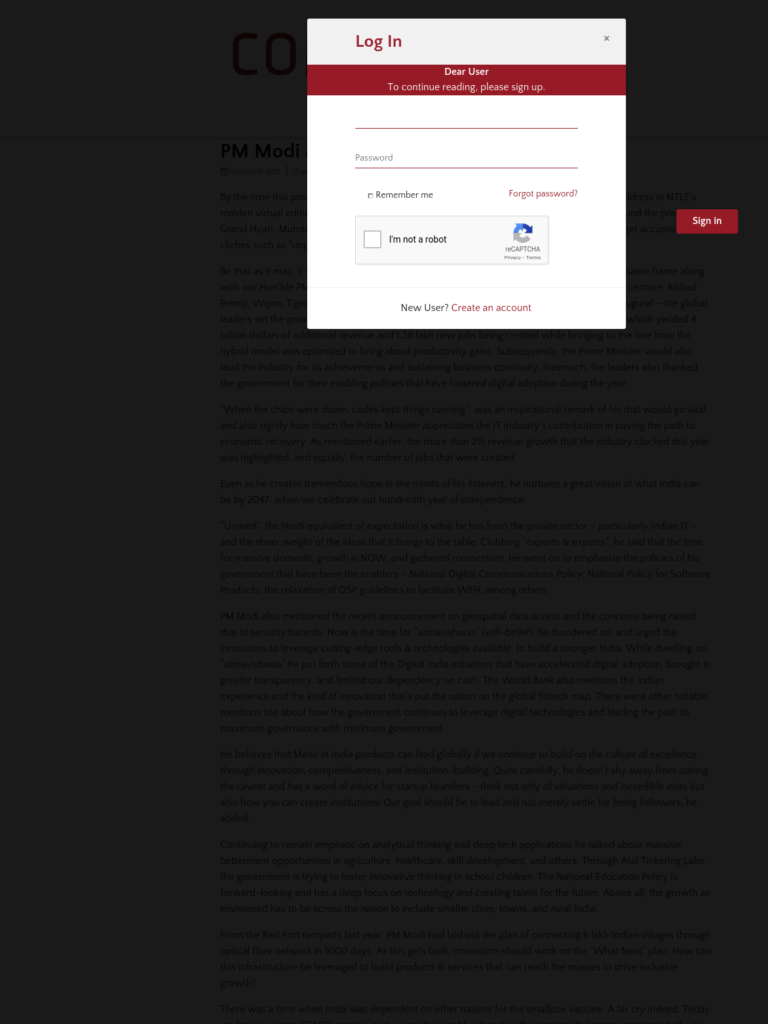PM Modi at NTLF Inaugural
Blog: NASSCOM Official Blog
By the time this post goes online, much would have been written & tweeted on PM Modi’s address at NTLF’s maiden virtual edition. When one is accustomed to seeing more than 1500 CXOs milling around the precincts of Grand Hyatt, Mumbai, every year, and filling out massive ballrooms, it takes a while even to get accustomed to cliches such as “unprecedented” times.
Be that as it may, it was a remarkable experience to see so many powerful individuals in the same frame along with our Hon’ble PM – Debjani Ghosh, NASSCOM, U.B. Pravin Rao, Infosys, Rekha Menon, Accenture, Rishad Premji, Wipro, Tiger Tyagarajan, Genpact & Sridhar Vembu, Zoho. Given the hour – NTLF inaugural – the global leaders set the preamble and took us through the industry-wide efforts in the last 12 months which yielded 4 billion dollars of additional revenue and 1.38 lakh new jobs being created while bringing to the fore how the hybrid model was optimized to bring about productivity gains. Subsequently, the Prime Minister would also laud the industry for its achievements and sustaining business continuity. Inasmuch, the leaders also thanked the government for their enabling policies that have fostered digital adoption during the year.
“When the chips were down, codes kept things running”, was an inspirational remark of his that would go viral and also signify how much the Prime Minister appreciates the IT industry’s contribution in paving the path to economic recovery. As mentioned earlier, the more than 2% revenue growth that the industry clocked this year was highlighted, and equally, the number of jobs that were created.
Even as he creates tremendous hope in the minds of his listeners, he nurtures a great vision of what India can be by 2047, when we celebrate our hundredth year of independence.
“Umeed”, the Hindi equivalent of expectation is what he has from the private sector – particularly Indian IT – and the sheer weight of the ideas that it brings to the table. Clubbing “exports & experts”, he said that the time for massive domestic growth is NOW, and gathered momentum. He went on to emphasize the policies of his government that have been the enablers – National Digital Communications Policy; National Policy for Software Products; the relaxation of OSP guidelines to facilitate WFH, among others.
PM Modi also mentioned the recent announcement on geospatial data access and the concerns being raised due to security hazards. Now is the time for “atmavishwas” (self-belief), he thundered on, and urged the innovators to leverage cutting-edge tools & technologies available, to build a stronger India. While dwelling on “atmavishwas” he put forth some of the Digital India initiatives that have accelerated digital adoption, brought in greater transparency, and limited our dependency on cash. The World Bank also mentions the Indian experience and the kind of innovation that’s put the nation on the global fintech map. There were other notable mentions too about how the government continues to leverage digital technologies and leading the path to maximum governance with minimum government.
He believes that Made in India products can lead globally if we continue to build on the culture of excellence through innovation, competitiveness, and institution-building. Quite candidly, he doesn’t shy away from stating the caveat and has a word of advice for startup founders – think not only of valuations and incredible exits but also how you can create institutions! Our goal should be to lead and not merely settle for being followers, he added.
Continuing to remain emphatic on analytical thinking and deep tech applications he talked about massive betterment opportunities in agriculture, healthcare, skill development, and others. Through Atal Tinkering Labs, the government is trying to foster innovative thinking in school children. The National Education Policy is forward-looking and has a deep focus on technology and creating talent for the future. Above all, the growth as envisioned has to be across the nation to include smaller cities, towns, and rural India.
From the Red Fort ramparts last year, PM Modi had laid out the plan of connecting 6 lakh Indian villages through optical fibre network in 1000 days. As this gets built, innovators should work on the “What Next” plan. How can this infrastructure be leveraged to build products & services that can reach the masses to drive inclusive growth?
There was a time when India was dependent on other nations for the smallpox vaccine. A far cry indeed. Today, we have our own COVID vaccine, and we are favourably placed on the vaccine diplomacy matrix globally, as we continue to cater to the needs of many countries.
So, what’s our vision for India 2047?
The post PM Modi at NTLF Inaugural appeared first on NASSCOM Community |The Official Community of Indian IT Industry.
Leave a Comment
You must be logged in to post a comment.








